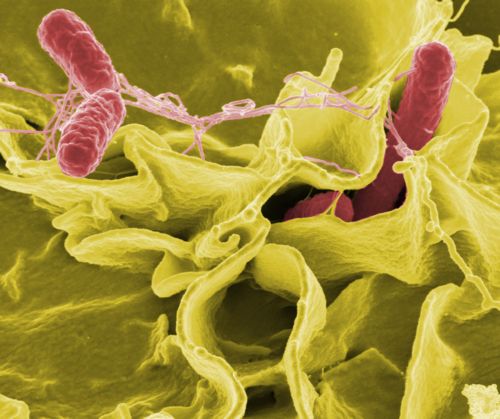Salmonella – Symptoms and Causes
Salmonella with its having garnered much media attention due to the outbreak involving peanut butter is a food borne illness. It is contracted by the ingestion of the salmonella bacteria. While often linked to poultry and poultry byproducts like eggs, salmonella bacteria can infect any food source as proven with the recent peanut butter outbreak. Other fairly recent cases of salmonella infestations have been linked to jalapeo peppers, cereal items, and tomatoes.
Food can become infected with salmonella bacteria in several ways. Causes of salmonella infection include food sources contaminated by feces of animal or human nature, cross contamination, contamination by water tainted with the bacteria, and poor food handling procedures.
Humans that have been infected at one time with salmonella bacteria tend to be carriers of it. It is especially important that these individuals take extra care to prevent passing along salmonella to others. The likeliness of passing the bacteria can be lessened if the infected individual practices proper hand washing techniques after using the bathroom, and by wearing food handling gloves when preparing food.
Animals said to be causes of salmonella contamination are turtles, household pets, and the majority of farm livestock. Salmonella infections caused by animals can be prevented by utilizing proper hand washing techniques after handling such animals.

Cross contamination simply put is when foods infected with bacterium such as salmonella come into contact with previously uncontaminated food items. Salmonella infection through cross contamination can be prevented through proper food handling procedures. These procedures include using separate cutting boards and utensils for different food groups. Keep poultry separate from beef and all meat separate from vegetables. In addition to these preventative measures, proper hand washing with antibacterial hand soap will also minimize this potential cause of salmonella infection. Food safety measures can also be taken by ensuring that poultry reaches the internal temperature of 175F. For an accurate reading, the thermometer (calibrated of course) should be inserted into the center of the thickest part of the meat.
Symptoms of salmonella infection are typically present with symptoms similar to the flu. Symptoms of salmonella include severe headaches, extreme abdominal pain, diarrhea, nausea, and vomiting. More than half of the instances of salmonella go undiagnosed and are written off as stomach flu. Symptoms of salmonella typically begin within 4-7 days of being infected with the bacteria. Medical attention should be sought for a proper diagnosis if symptoms are present for longer than 2 days especially in the extremely young or in seniors.
Individuals with compromised immune systems including the young and elderly are more likely to suffer complications of salmonella infections, in fact nearly 600 individuals die each year from salmonella bacteria. Salmonella can be prevented by taking precautions while handling and preparing foods. Understanding the causes and symptoms of salmonella bacteria is the best defense in preventing outbreaks of salmonella contamination.
What is Salmonella?
Salmonella is a genus of rod-shaped, Gram-negative, non-spore forming, predominantly motile enterobacteria with diameters around 0.7 to 1.5 m, lengths from 2 to 5 m, and flagella which project in all directions (i.e. peritrichous). They obtain their energy from oxidation and reduction reactions using organic sources and are facultative anaerobes; most species produce hydrogen sulfide, which can readily be detected by growing them on media containing ferrous sulfate, such as TSI.
Salmonella are closely related to the Escherichia genus and are found worldwide in warm- and cold-blooded animals, in humans, and in nonliving habitats. They cause illnesses in humans and many animals, such as typhoid fever, paratyphoid fever, and the foodborne illness salmonellosis.
Salmonella as Disease-Causing Agent
Salmonella infections are zoonotic; they can be transmitted by humans to animals and vice versa. Infection via food is also possible. A distinction is made between enteritis salmonella and typhoid/paratyphoid/salmonella, whereby the latter because of a special virulence factor and a capsule protein (virulence antigen) can cause serious illness, such as Salmonella enterica subsp. enterica Serovar Typhi, or Salmonella typhi). Salmonella typhi is adapted to humans and does not occur in animals.
Enteritis Salmonella (e.g., Salmonella enterica subsp. enterica Serovar Enteritidis, for short Salmonella enteritidis or Salmonella typhimurium ) cause diarrhoea which usually heals spontaneously and does not require antibiotic treatment. However, people at risk such as infants, small children, the elderly, HIV patients and those with suppressed immunity can become seriously ill (general infections).
In Germany Salmonella infections must be reported ( 6 and 7 of the German law on infectious disease prevention = Infektionsschutzgesetz). Between 1990 and 2005 the number of officially recorded cases decreased from ca. 200,000 to ca. 50,000. It is estimated that every fifth person in Germany is a carrier of Salmonella. In the USA there are approximately 40,000 cases of Salmonella infection reported each year. Worldwide the WHO reckons with over 16 million typhoid fever infections annually, over half of them fatal.
Salmonella can survive for weeks outside a living body. They have been found in dried excrement after over 2.5 years. Sunlight (ultraviolet radiation) accelerates their demise; they perish after being heated to 55 degrees C for one hour, or to 60 degrees C for half an hour. To protect against salmonella infection, it is recommended that food be heated for at least ten minutes at 75 degrees C (temperature at the center). The bacteria are not destroyed by freezing. Salmonella die rapidly in acid media, and common disinfectants destroy them within a few minutes.
